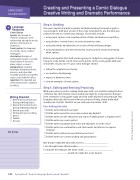Page 205 - SpringBoard_ELD_Grade8_Flipbook
P. 205
EMbEDDED AssEssMENt
Creating and Presenting a Comic Dialogue Creative Writing and Dramatic Performance
Language
Resources
Comic Syntax
Syntax, also known as sentence structure, is the relationship among the words, phrases, and clauses in sentences.
Comic syntax, the language
of comedy, relies on these techniques:
description: the type of writing that creates a colorful, exact picture of a person, place, object, or event juxtaposition: a writing technique that places words, phrases, and ideas that normally wouldn’t go together next to each other for effect repetition: the repeated use of the same words or phrases for effect.
Writing Checklist
Review the Student Comic Dialogue Writing Rubric Review the Student Comic Dialogue Writing Exemplar Review your draft Participate in peer editing Revise
Publish Present
My Notes
Step 4: Drafting
Use your completed graphic organizer and brainstorming document as guides as you begin to draft your version of the scene. Remember to use the skills you practiced in Unit 3 to create your dialogue. Those skills include:
• using comic syntax, such as juxtaposition of ideas and humorous repetition.
• using diction, or word choice, to create a humorous tone.
• using vivid verbs and adjectives to create colorful and funny images.
• using exclamations and other words that convey special emotional meaning when spoken.
Before you begin the first draft, work in groups to study the scoring guide. It shows how your script will be scored. Discuss the points on the scoring guide with your classmates. As you can see, your comic dialogue should:
• follow the original scene closely. • use modern-day language.
• express a humorous tone.
• contain examples of comic syntax
Step 5: Editing and Revising/Practicing
With your partner, practice reading aloud your draft, one student reading the lines of Hermia, the other Helena. Discuss what you might do to improve the dialogue. Then review the scoring guide again and look at the Student Comic Dialogue Text Exemplar, which you will receive from your teacher. Finally, switch drafts with another pair. Use this checklist as you read your classmates’ draft.
Peer Editing Checklist
Did the writer follow the prompt?
Did the writer revise the scene into modern-day English?
Did the writer use the characters and action of Shakespeare’s original scene?
Did the writer use comic syntax?
Did the writer substitute vivid verbs and adjectives to create color?
Did the writer use exclamations and other words and phrases to express feelings?
Did the writer achieve an overall humorous tone? Did the writer use correct spelling and punctuation?
One thing I really liked about this scene is I also thought it was effective when
To improve the dialogue, the writer could
would also make the scene funnier.
. .
.
182 SpringBoard® English Language Development Grade 8
© 2017 College Board. All rights reserved.


